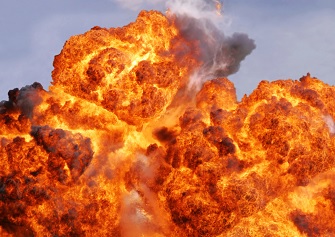In a new fact sheet, Safe Hot Work Practices, the U.S. Chemical Safety and Hazard Investigation Board (CSB) says that explosions and fires caused by hot work are among the most common incidents it investigates.
“These incidents typically result in injuries and fatalities and have the potential to result in a major catastrophic incident,” states the CSB.
The fact sheet condenses a February 2010 CSB Safety Bulletin, Seven Key Lessons to Prevent Worker Deaths During Hot Work In and Around Tanks. The CSB notes that these items have since been incorporated into the International Code Council 2015 International Fire Code, in a new Section 3510, Hot Work on Flammable and Combustible Liquid Storage Tanks.
“Hot work” is defined as burning, welding, or similar operations that can ignite fires or explosions. According to the CSB, the most common causes of worker death due to hot work are explosions and fires due to flammable atmospheres in confined spaces. Hot work is conducted in many industries, although the CSB says that most of the incidents it has investigated involved tanks or containers holding flammables at high-hazard facilities, such as refineries and chemical plants.
Worker Fatalities in 2017 Incident
The fact sheet lists 15 hot work-related accidents the CSB has investigated since 2001. The most recent of these occurred in February 2017 at a Packaging Corporation of America facility in DeRidder, Louisiana. Workers were welding water piping near a foul condensate tank. The tank exploded, killing three workers and injuring seven; all the workers were contractors.

The CSB investigation found that oxygen in an amount sufficient to support combustion entered the tank and combined with turpentine vapor to form an explosive mixture. The explosion heavily damaged the surrounding process equipment. The tank itself traveled approximately 375 feet and over a six-story building before landing on process equipment. The CSB said the hot work was probably the source of ignition, although other possible sources could not be excluded.
The Seven Lessons
Based on its investigation, the CSB highlights the following lessons learned:
- Use alternatives. Whenever possible, avoid hot work, and consider alternative methods.
- Analyze the hazards. Before the initiation of hot work, perform a hazard assessment that identifies the scope of the work, potential hazards, and methods of hazard control.
- Monitor the atmosphere. Conduct effective gas monitoring in the work area using a properly calibrated combustible gas detector before and during hot work activities, even in areas where a flammable atmosphere is not anticipated.
- Test the area. In work areas where flammable liquids and gases are stored or handled, drain and/or purge all equipment and piping before hot work is conducted. When welding on or in the vicinity of storage tanks and other containers, properly test and, if necessary, continuously monitor all surrounding tanks or adjacent spaces for the presence of flammables, and eliminate potential sources of flammables.
- Use written permits. Ensure that qualified personnel familiar with the specific site hazards review and authorize all hot work and issue permits specifically identifying the work to be conducted and the required precautions.
- Train thoroughly. Train personnel on hot work policies/procedures, proper use and calibration of combustible gas detectors, safety equipment, and job-specific hazards and controls in a language understood by the workforce.
- Supervise contractors. Provide safety supervision for outside contractors conducting hot work. Inform contractors about site-specific hazards, including the presence of flammable materials.
CSB’s fact sheet is available here.

